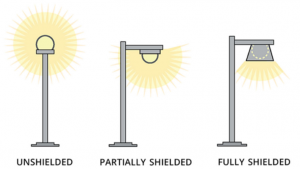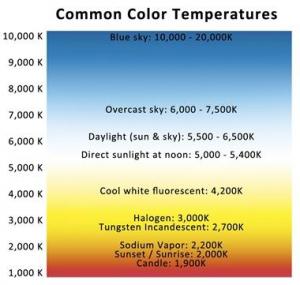Dark Sky Ordinance
On January 18, 2024, the Brisbane City Council adopted an ordinance adding Chapter 15.88 Outdoor Lighting Standards to the Brisbane Municipal Code to protect and enhance the local environment and public health by reducing light pollution at night through reasonable restrictions on outdoor lighting. For the Outdoor Lighting Regulations of residential and commercial properties, please find the handouts here.
Effective Dates:
- Starting March 1, 2024, if you are replacing or installing new outdoor lighting on your property you will need to make sure that the bulbs and fixtures comply with new regulations that control the brightness, color, and other characteristics of outdoor lighting.
- By March 1, 2025, existing lighting shall be modified where feasible: directing light downward if possible, adjusting dimmers and motion timers to comply where lighting is equipped with them, and replacing bulbs to meet color and lumen thresholds when they are replaceable.
- By March 1, 2029, all existing lighting at commercial properties shall be brought into compliance.
- By March 1, 2034, all existing lighting at residential properties shall be brought into compliance.
- By March 1, 2039, all streetlights and other City facilities shall be brought into compliance.
Of course, you can choose to comply BEFORE the deadlines hit! If you do, please share your photos with us (General Question Form). You'll receive free swag from the City's official web store, Betsy, as a token of our appreciation!
Exceptions to these deadlines for existing outdoor lighting may be requested in writing up to 90 days before the deadline for financial hardships. Existing lighting that does not comply with the ordinance by the deadline must be turned off if it is not replaced with compliant lighting.
Is my lighting exempt from regulations?
- Indoor lighting. The new regulations apply ONLY to outdoor lighting.
- Temporary construction or emergency lighting. Construction hours set forth in Chapter 8.28 of the BMC still apply.
- Address identification lighting that complies with the Building Code.
- Low-intensity landscape lighting. This includes landscape lighting that emits no more than 300 lumens per fixture, or 100 lumens per fixture for dynamic lighting. Lighting must be pointed downward.
- Combustible fuel lighting. This includes fire pits, lanterns, or torches when used temporarily in occupied areas.
WHAT ABOUT BRISBANE STARS and seasonal/holiday lighting?
Brisbane Stars are allowed year-round, while other seasonal/holiday lighting may only be illuminated September 15 to January 31. Both are subject to curfew but are not required to comply with other ordinance requirements.
Requirements for non-exempt outdoor lighting:

SHIELDING
All outdoor lighting must be fully shielded; that is, the bulb or light source must be shielded by an opaque covering.
Shielding exemptions:
- String lights (max. 300 lumens per string) when used in occupied decks or patios.
- Dynamic lights (max. 100 lumens per fixture) when used in occupied residential and commercial decks or patios.
- Seasonal lighting.
- US or CA flag lighting (partial shielding required).
LIGHT TRESPASS
Unless exempt from the ordinance or from the shielding requirements in the ordinance, no light source (e.g., light bulb) may be directly visible from off-site.
LIGHTING LOCATION
All properties: Lighting at the property line must be controlled by motion sensor that extinguishes lights 10 minutes or less after activation.
Residential: Outdoor lighting can only be used within 50 feet of residentially habitable buildings or swimming pools, driveways and walkways.
CURFEW
Residential: 10 PM
Commercial: 10 PM or close of business, whichever is later.
Automated control systems (photocells, motion sensors, timers, etc.) must be employed at commercial properties. Automated controls are acceptable and encouraged at all properties.
Curfew exemptions:
- Lighting activated by motion sensor which extinguishes 10 minutes after activation.
- Lighting at building entrances, residential parking areas and driveways, and commercial parking entrance and egress points.

LIGHTING COLOR
The correlated color temperature (CCT) of outdoor lights must be 3,000 Kelvin or less (except seasonal lighting and Brisbane Stars).
Lighting Levels by Zoning District
The ordinance limits the total illumination, measured in lumens, generated by all exterior lighting on a given property. Maximum illumination limits vary by district and land use, and are based on either the developed lot area (roughly equivalent to the lot coverage) for residential uses or area of hardscape (i.e., driveways, parking lots, patios) for commercial uses.
| Zoning District | Maximum Lumens per Square Foot of Hardscape | Maximum Lumens per Square Foot of Developed Lot Area |
|---|---|---|
| O-S | 0.35 | |
| MLB, R-BA | 0.875 | |
| NCRO-2, PAOZ-1, PAOZ-2, PD (residential uses only), R-1, R-2, R-3, R-MHP | 1.75 | |
| NCRO-1, SCRO-1, SP-CRO, HC, M-1, TC-1, TC-2, C/PU | 3.5 | |
| All other zoning districts and uses not named | Determined at time of application or closest applicable district as determined by the Community Development Director | |
What if I can't comply?
The Community Development Director or City Engineer can approve requests for deviations from the outdoor lighting standards if there are unique circumstances affecting your property or unique design and land use characteristics that make it infeasible or impractical to comply with strict application of the lighting standards detailed in this chapter.
